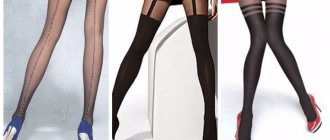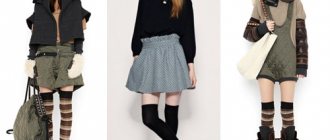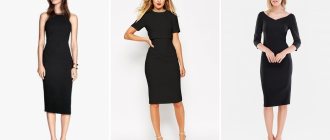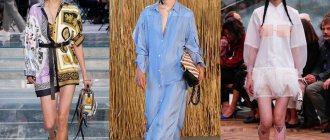Types of compression garments
Before wearing compression hosiery , you need to navigate the current range of models.
Most manufacturers make products from microfiber, nylon, lycra or cotton threads. The machines allow you to create a circular seamless weave that provides comfort while wearing. The elastic component is located inside the product, in a braid of fibers.
- Tights - tightly fit the legs, fit at waist level. Due to the soft belts and high elasticity of the material, they do not slip during wear. Help prevent the development of hemorrhoids. Externally, the product is no different from ordinary nylon tights.
- Stockings are a more practical option for use, requiring some skill and practice when putting them on. The stocking is very tight and dense; it requires some effort to pull it evenly over the limb. Cuffs can be universal for men and women, or with lace inserts.
- Knee socks are compact and comfortable, not visible from under clothes. Can be shortened or standard height. The elastic band is located below the knee. Unisex style product. The reinforced heel reduces pressure on the feet during active activities. The toe can be open or closed. Some brands have Velcro or zipper options for ease of putting on.
- Socks are often used by men at the initial stage of development of vein diseases. They look laconic, fit comfortably on the shin due to the thick elastic band and are made in various shades.
7 recommendations for choosing
Want to know how to wear compression stockings ? We advise you to first decide on the correct selection of products. This is influenced by a number of factors.
- Decide on the purpose of use: prevention, treatment or in the postoperative period.
- Visit a doctor to select the desired height of the product: tights, stockings, knee socks, socks.
- Buy compression boots strictly according to the required compression class.
- Choose the size based on the table indicated on the manufacturer's packaging. Before visiting the store in the morning, take measurements of the half-girth of the limbs: in the lower leg area, under the knee, in the middle of the thigh, under the buttock.
- When choosing a brand, pay attention to brands with a reputation as a reliable manufacturer who has been in this field for a long time.
- Take a closer look at the quality of tailoring: there should be no pronounced seams or joints, the material should look uniform in texture and color, and have excellent stretch.
- The final cost of the product depends on the quality of the materials used, innovative production techniques and international certification.
How to put on stockings, tights, stockings or socks?
All therapeutic and prophylactic products in this range are put on in a similar way without additional tools.
- Remove from packaging and carefully straighten.
- Place your hands, clenched into fists, into the stocking and grab the heel area.
- Turn inside out, without letting go of the toe part, check for wrinkles.
- Insert your foot into the “pocket” that has formed. The heels of the jersey and the wearer should match without twisting.
- Carefully grasp the fabric a couple of centimeters from the ankle and pull upward.
- Grabbing 5 cm at a time, move higher up the leg, tightening the compression garment.
- Smooth the surface so that there are no wrinkles anywhere.
If your tights have an open toe, you should use the special silk socks that come with the kit.
In the case of low socks and knee socks, you can cope without additional devices.
TO WEAR OR NOT TO WEAR
Those who fanatically defend the purist point of view on this Hamlet dilemma forget one thing: modern fashion considers any rules from the point of view of context. And with regard to stockings and tights, the context may be:
- climatic
- stylistic
- class
- cultural
- age
- …
So, for example, April in New York and April in Moscow are, as they say, two big differences. In Manhattan, cherry blossoms bloom in the parks and the average temperature is around 15-17 degrees, and in our latitudes the thaw gives way to night frosts, and bare legs in this context look comical (or even tragic).
The stylistic context also makes its own adjustments - tights of different densities, colors and patterns can be the main accessory on which the entire look is built. And every season there are current topics that bring certain types of tights to the forefront (in 2019, for example, fishnet, that nightmare of Anglo-Saxon purists, is again relevant).
The cultural context determines the requirements for image as a whole: in a business environment (or in any formal situations such as weddings, funerals, business brunches and political events) bare legs are taboo, even in the hottest months of summer, but in an informal environment it is quite You can do without tights. And the class context separates those who travel by private transport and can afford to run in thin tights or without them at all from the car to the restaurant, and those who wait for the bus at the bus stop in temperatures around zero (or even lower). It’s much easier to be a style snob while sitting in a warm car than standing at a bus stop, whatever.
Well, age (and, above all, the condition of the legs) also imposes its limitations, and the unspoken rule says that the older the woman, the more often it is worth choosing high-quality nude tights or stockings strictly in skin tone (which have a Photoshop effect and are practically invisible ).
In other words, there is no single point of view on the topic of tights - no matter how the “tights” purists break their spears, there are too many variables in this equation to get a clear answer.
Kate, tweed, thick black tights and suede closed shoes are an impeccable winter (we're talking about European winter, of course) combination.
“STOCKING ETIQUETTE” OR WHAT THE FIGHT IS ABOUT
If you missed everything, and until today were in blissful ignorance, then here is a summary of the previous episodes of the “tights thriller”.
Among purists and adherents of impeccable style, most of whom live in New York and London (in Paris, everyone is somehow more relaxed on the topic of tights, unlike the Anglo-Saxon capitals), the following rules are accepted:
- tights (stockings) can be worn from October 1 to March 31; from the beginning of April until the end of September, wearing tights is bad form (that is, your legs should be bare);
- tights are not worn AT ALL in the summer - this is regarded as a crime against humanity;
- Tights and stockings are not worn with shoes without heels (ballet shoes, for example).
Then the army of tights snobs is divided into two camps: some of them fanatically defend the right of women to wear colorless invisible tights that match their skin tone, while the other part recognizes only black tights (both thin and thick), considering colorless tights profanity (they say they don’t keep you warm). They warm them up, and still there are at least a little of them, but you can see - what’s the point in them anyway?..).
The apologists of the first approach are the stylists of the English royal family (according to etiquette, women in this family never appear in public with bare legs). And the most prominent representative of the second camp is Anna Wintour, who, at 70, famously flaunts her bare legs at the February shows (and very rarely wears tight tights in winter, combined with high boots).

Kate Middleton, even on the hottest days, does not appear in public with bare legs. The tabloids write that Queen Elizabeth hates violations of this rule, and all the women in the family clearly know that without stockings and tights you can only walk around your part of the palace when no one can see you. Difficult royal everyday life.

Anna Wintour with bare legs at the shows of cruise collections in January this year.

And just to give you an idea of the seriousness of the matter, here's Emma Stone bare-legged at Paris Fashion Week (which takes place at the end of February). Such a contrast - bare legs and a coat - does not bother anyone, although it seems completely wild to most residents of the former Soviet republics.

And a slightly less radical version of Camille Charrière, in which bare legs are still at least somehow protected by a long cloak. Russian grandmothers in a pre-infarction state predict cold appendages for her, but a resident of London and one of the top bloggers on the planet doesn’t care about Parisian February...
Slightly less fanatical-minded citizens adhere to the “oyster rule” - you can wear tights only in those months whose names have the letter P, and the density of tights can vary depending on the temperature outside the window.
But still, the attitude towards tights remains wary - the rule “If in doubt, go without” is still considered the gold standard of “stocking etiquette”.
QUESTION PRICE
Most of the definitive posts that you will find on the topic will be supported by images of Kate Middleton - purists of style love to use her as heavy artillery.
They say, if anyone has the right to a decisive vote in matters of wardrobe etiquette, it is the stylists of the royal house, who vigilantly monitor compliance with all the rules of good taste!

Nude tights strictly match the skin tone - that same “Photoshop effect”.

So if you are from the purist camp, then just study the selection of images of the Duchess on the topic of what tights she wears, where and with what. However, there are mistakes in the royal family: Meghan Markle, for example, sometimes kicks up and flaunts her New York-style bare legs. And, by the way, the planet does not leave its orbit...

Duchess Kate loves Wolford tights, and these are what she wears most often on her legs (according to the tabloids). In general, there is a fairly common misconception about tights and the fact that they are a consumable element of the wardrobe, so there is no point in spending a lot on them.
This is wrong.
In fact, it’s not just that premium segment tights are several times more expensive than mass-market brands; they are very different visually (they look different on the leg) and are much stronger (double-coated fiber is most often used), so they last much longer. And in terms of the cost of wearing, one pair of expensive tights costs less than one pair of ordinary ones. I still have a pair of thin Wolfords that I wore when I got married ten (!) years ago, and which I wear quite actively.
Premium brands (DKNY, Wolford, Falke, Gerbe, Fogal) make stockings and tights not only from lycra; the thinnest pairs are most often made from a mixture of polyamide and polyurethane, sometimes with the addition of silk to the yarn. These tights are very comfortable to wear, softly reflect light (the effect is visually very close to how skin reflects light), they do not feel heavy and there is no desire to take them off immediately after a very long day.
And even in shape, expensive tights differ from mass-market ones, since they follow the physiological curves of the body (inexpensive tights are most often just straight) and therefore fit like a glove, without bunching up at the ankle. They have a different seam technology (Wolford even patented the gluing of fabric, so their tights are truly seamless), and the elastic does not dig into the stomach (and does not slip when walking down).
In other words, if you have never invested in expensive tights before, and if you have the opportunity, then give yourself such a gift - just for the sake of experimenting. Perhaps this purchase will seriously help you save on constant spending on inexpensive tights, which are often thrown away after 3-4 wears.
Expensive tights can be machine washed in a laundry bag (the bag must have a secure zipper), on a gentle cycle without drying, or washed by hand. With relatively careful use and proper care, the pair will serve you for many years.

BASIC RULES
So, if you decide to figure out how (and when) to wear tights for you, then you need to first decide what role they will play in the image:
- functional;
- accent (which may well be combined with functional).
Functional tights will be flesh-colored and black, without patterns or any decorative elements. At the same time, there are certain generally accepted rules for choosing such tights:
- nude tights should strictly match the tone of your skin (all these tanning effects and so on are from the evil one);
- nude tights should not be thicker than 40 den and should not be shiny (unless we are talking about a designer accent pair), and the thinner they are, the better (more natural) the leg looks;
- black tights can be either thin (they are worn in all black looks or in evening versions, where even tights with glitter are appropriate) or thick (such tights are worn in the cold season, from October to the end of March);
- the denser the black tights, the denser the clothes and the more massive the shoes should be; this rule does not apply to flesh-colored tights-stockings (since it is assumed that dense flesh-colored tights are not worn in principle).
Globally, etiquette implies that flesh-colored tights pretend to be as invisible as possible, and should not provide warmth (therefore, purists consider thick flesh-colored tights to be a sign of bad taste), and black tights are worn in the cold season, they are visible, and their main task is to warm.
And if it’s cold outside and the dress code doesn’t allow you to wear black tights, then it’s better to wear trousers, purists say, rather than going down to thick nude tights that turn even the most beautiful legs into sausages.
This is such suffering for the glory of impeccable taste.

Alexa Chung and black translucent tights in a spring combination with leather and cashmere.











